| Columns Retired Columns & Blogs |
Exposure CD Player Measurements
Sidebar 3: Measurements
The Exposure's non–loop-feedback single-ended analog stages would make one anticipate some moderate distortion at peak level, and this was indeed present. I should also note that my first sample showed a near-inaudible high-frequency tone in the right channel. The second sample, taken at random from the production line, was in the clear. Exposure will report back when they've checked this out; an out-of-spec DAC chip is suspected.
Track access was quick—2.5 seconds for track 15 of the Sony test disc—while the gap error correction rated average, at 1.0mm for the usual Pierre Verany test set. Shock and vibration resistance were rated as "good," despite the absence of significant isolating feet. This player ran quietly, with no transformer hum, and little noise save those intertrack relay clicks.
The player's frequency response with a 100k ohm test loading was wide and flat (fig.1), with negligible ripple and just a hint of rolloff by 20kHz, this the –0.25dB point. De-emphasis showed a mild 0.5dB "dulling" in the mid-treble, recovering thereafter. Loaded by a severe 600 ohms, the full level distortion rose a little, while the low-frequency –3dB point moved up from below 3Hz to 17Hz. Any loading down to 10k ohms should be just fine with this player, with negligible loss of bass extension. The two channels were very similar, matched to 0.04dB over much of the range, and just 0.1dB different at 20kHz. There was no interchannel phase difference, and the output was close to minimum phase, absolute phase correct.
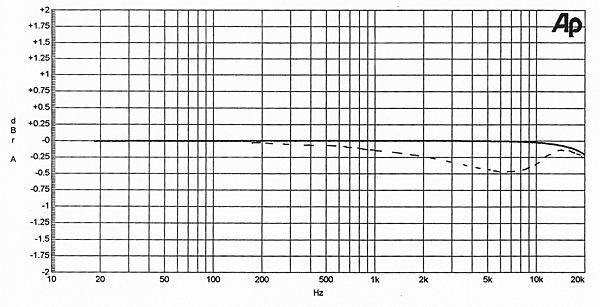
Fig.1 Exposure CD player, frequency response (solid) and de-emphasis response (dashed) (0.25dB/vertical div.).
Channel separation was fine, crosstalk remaining below –100dB or so at low frequencies, increasing to a very good 90dB in the midrange and treble. The Exposure's full-scale output was 0.12dB higher than the industry standard 2V, generated from a very low 1.0 ohm output impedance. (This figure includes the low-resistance output cable—perhaps the circuit features a trace of negative output impedance?)
At full-level, the distortion on a single tone just bettered –80dB (0.01%), and was of a low-order analog-type variety. At –10dBFS, the distortion was quite normal at –79dB, 0.011%. Similar results were seen for the full-level high-frequency intermodulation, the 1kHz difference product reading –83.6dB (fig.2). Some mild noise was evident at below –100dB, but the fundamentals were quite clearly defined. However, the first difference-tone products with the 44.1kHz sample clock at 24.1kHz and 25.1kHz were only 3.3dB down. This is where the lower-cost filter implementation shows itself, but it could be argued that full-level, two-tone, high-frequency excitation rarely happens in music. On the other hand, a loud cymbal crash will dump multitone energy in this upper band, and the additional, if nominally inaudible, beat products will add to the workload for the system amplifier. Furthermore, such a beat tone might just lie on the resonance peak of a low-loss metal-dome tweeter, thus increasing its subjective audibility for younger bat-eared listeners! The result did improve at a more realistic –10dBFS level. Here the 1kHz difference tone was held to a very satisfactory –88dB with rather less ultrasonic products evident.
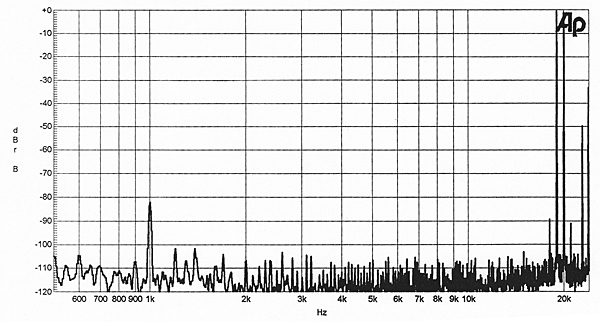
Fig.2 Exposure CD player, HF intermodulation spectrum, DC–24kHz, 19+20kHz at 0dBFS (log frequency scale, 10dB/vertical div.).
Fig.3 plots the spectrum of the Exposure's spurious ultrasonic tones up to 88kHz for a –70dB dithered 1kHz tone (this is just visible at the left-hand edge of the graph). There is nothing of significance to note here, save that ultrasonic spuriae were better than 110dB down—more than fair enough—while the low-pass filtering accelerated beyond 83kHz.
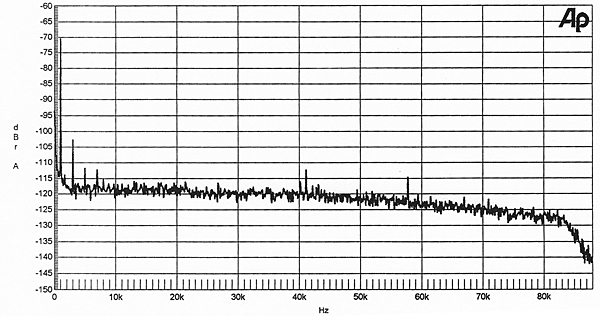
Fig.3 Exposure CD player, spectrum of dithered 1kHz tone at –70dBFS, DC–88kHz, with noise and spuriae (linear frequency scale, 16-bit data).
Looking in more detail at the spectral analysis of the –70dB tone (fig.4), the odd-order distortion apparent is due to a mild kink in the DAC's transfer function. The third harmonic was at –35dB; that is, 105dB below peak level. There was rather less fifth and seventh harmonic present (at –113dB), after which lower levels of even-order harmonics reasserted themselves.
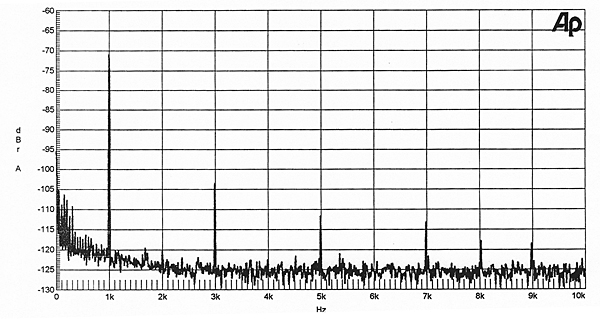
Fig.4 Exposure CD player, spectrum of dithered 1kHz tone at –70dBFS, DC–10kHz, with noise and spuriae (linear frequency scale, 16-bit data).
I repeated this analysis 20dB lower, at –90dB modulation (fig.5). Now some desirable second harmonic was present, and the third-harmonic residual had fallen to –110dB relative to full level. Sidebands were low in level, indicating very good clock stability, while the hash at the start of the trace was no more than a set of low-level, inaudible hum components at the 50Hz repetition rate of the UK mains supply. Total harmonic distortion at –90dB measured a satisfactory –15dB.
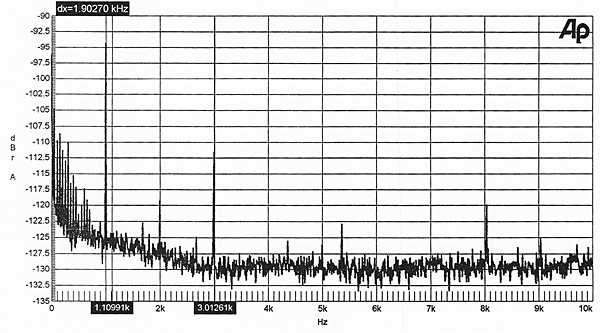
Fig.5 Exposure CD player, spectrum of dithered 1kHz tone at –90.31dBFS, DC–10kHz, with noise and spuriae (linear frequency scale, 16-bit data).
The Exposure's digital filter/DAC combination automatic mutes when it encounters a digital zero signal. Measuring the S/N Ratio required use of the lowest-level tones on CBS Test Disc 1, by which artifice I got a modest 89dB unweighted figure, 89dB CCIR (1kHz) ARM-weighted, with 92dB A-weighted signal/noise ratios. A S/N Ratio of better than 110dB is possible with some designs, so these figures were more comparable with a tubed preamp than a solid-state IC circuit design. Hum itself was better than 105dB down.
The audio waveform showed no signs of premature compression on peak-level white noise, and RF leakage above 100kHz was well-controlled, better than 40dBm down. Fig.6 charts the low-level linearity for the poorer of the two channels. It shows a fine result down to –75dBFS, but a moderate 2–3dB deviation by –95dB, and a recovery toward –105dB. Encroaching system noise is seen below that point. While this result was unexceptional, I don't think it's a cause for concern. Associated with the low-level linearity error, the Exposure's noise modulation graph (fig.7), plotted for three level of the low-frequency fundamental (–50, –70, and –90dB), shows some divergence for the lowest level tried. There's not much to choose between the others, and the overall result was quite typical. Little to report here.
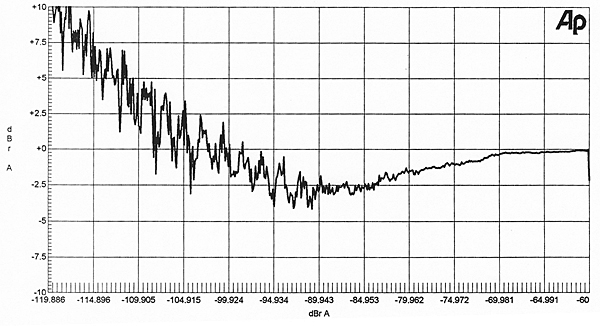
Fig.6 Exposure CD player, departure from linearity (2.5dB/vertical div.).
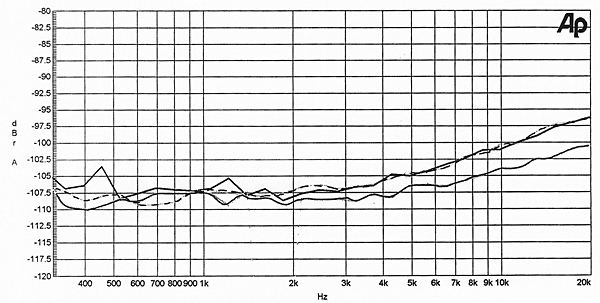
Fig.7 Exposure CD player, noise modulation, 41Hz at –50dBFS to –90dBFS (2.5dB/vertical div.).
Clearly, this was not one of the more linear CD players tested. Yet there was nothing that would warn, "Danger, you may hear this error!" In general, distortion was low and the channels were neutral and well-balanced, having moderate noise and good separation. De-emphasis was tolerably accurate (and little used these days anyhow), while the output stage was something of a pile driver.—Martin Colloms
- Log in or register to post comments



































